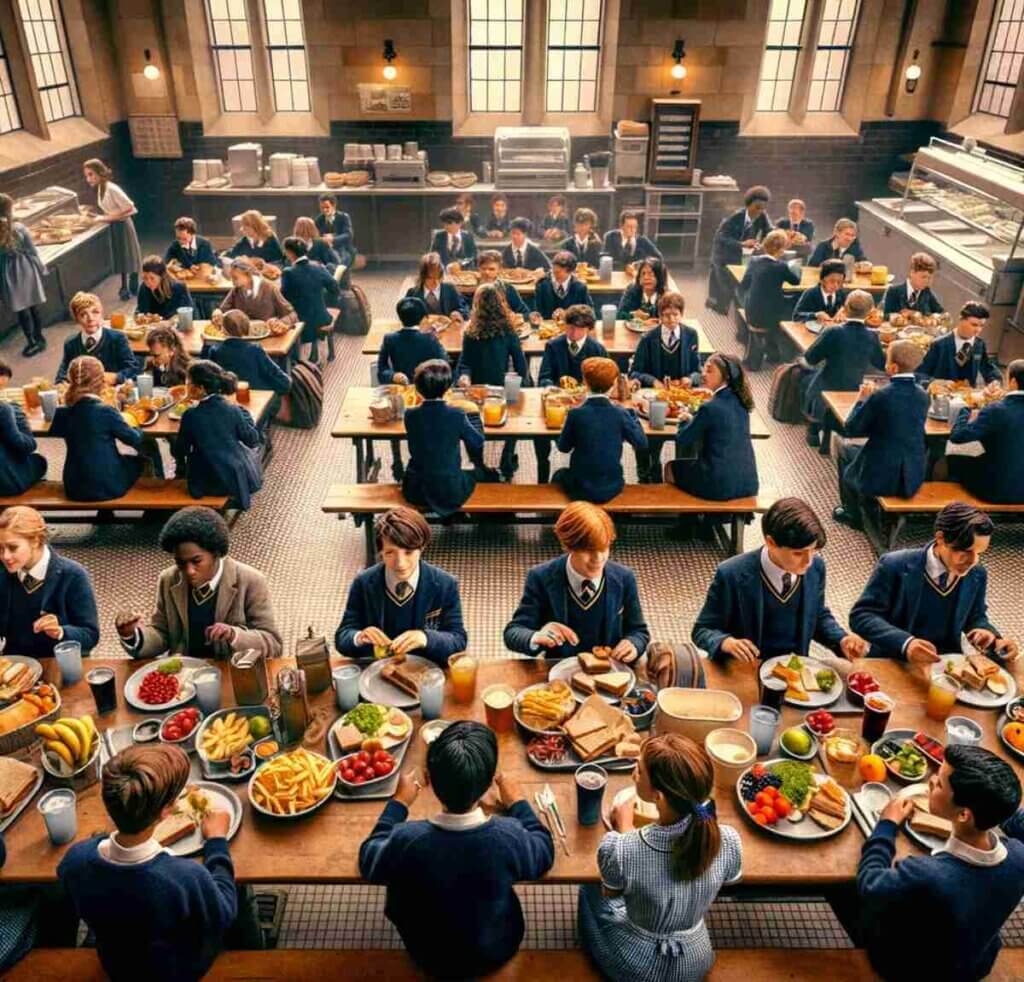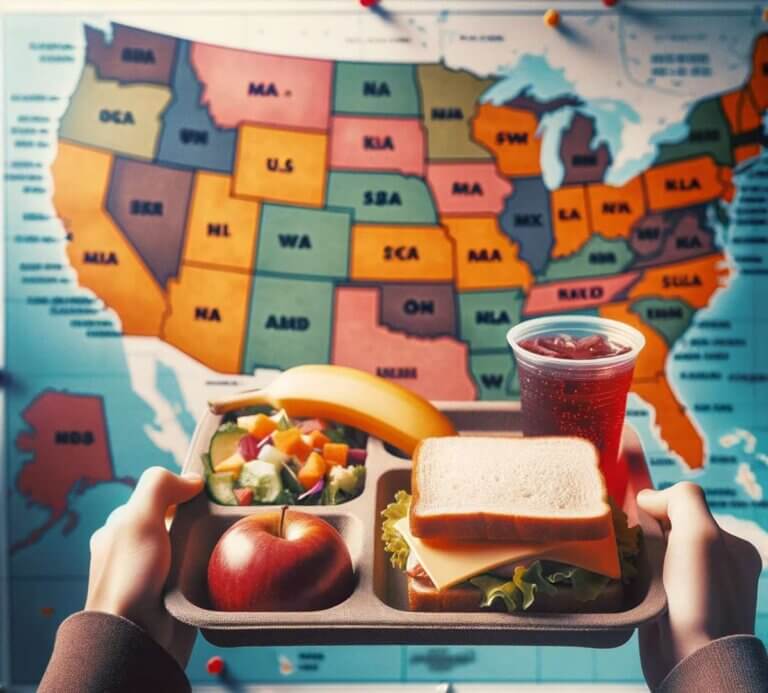School Meals Around the World: U.S. and World’s Best Practices Compared

We’ve always been fascinated by how different cultures approach something as fundamental as school lunches. From the United States to the far reaches of Japan and the cozy corners of Italy, school lunches reflect not just culinary traditions but also educational philosophies and social priorities. Let’s take a culinary journey around the world to understand how various countries approach school lunches and what the U.S. can learn from them.
Table of Contents
Top Countries Excelled in Their School Lunch Approaches
Exploring how countries approach school lunches provides valuable insights. These international perspectives highlight the importance of nutritional balance, cultural diversity, and the role of school meals in education and social equality. By drawing inspiration from these global practices, our states can continue to enhance and evolve its approach to school nutrition.
Japan: The Harmony of Nutrition and Education

Japanese school lunches, or “kyushoku,” are a marvel of balance and nutrition. These meals often consist of rice or bread, a protein source like fish or meat, a soup, and a side of vegetables. What’s remarkable is the educational aspect: students serve each other, fostering a sense of community and responsibility. In Japan, lunchtime is an extension of the classroom, teaching children about nutrition, hygiene, and social skills.
Parent’s Perspective: I admire how Japan turns lunchtime into a practical lesson in community and responsibility. The U.S. could benefit from integrating such social learning aspects into our lunch programs.
From an Education Expert’s Lens: Integrating the act of serving and cleaning up teaches valuable life skills and respect for food, something that could greatly enhance the U.S. education system.
Italy: Freshness and Locality

In Italy, school lunches often resemble a home-cooked meal, focusing on fresh, local ingredients. A typical menu might include pasta, a main course of fish or meat, a side of vegetables, fruit, and sometimes, a delicious dessert. The emphasis is on fresh, seasonal produce, and traditional cooking methods.
Parent’s Perspective: The Italian approach makes me yearn for more fresh, locally-sourced ingredients in our schools, moving away from processed foods to embrace the joy of real, wholesome cooking.
Education Expert’s Viewpoint: Promoting local agriculture through school lunches can not only improve nutrition but also boost local economies and teach children about sustainable practices.
France: A Lesson in Culinary Excellence

French school lunches are a culinary journey. These multi-course meals often start with a salad, followed by a main dish, cheese, dessert, and end with a fruit. The focus is on savoring each bite and learning about good food from a young age.
Parent’s Perspective: The French way instills a love and appreciation for good food. In the U.S., we could aim to make lunchtime a more gourmet experience, encouraging kids to appreciate diverse flavors.
Education Expert’s Insight: The French approach is a testament to the idea that exposing children to a variety of tastes can develop their palate and make them more open to trying new foods.
South Korea: Nutritional Balance and Variety

South Korean school lunches are known for their variety and balance. A typical meal includes rice, soup, a main dish of meat or fish, and a variety of side dishes including kimchi. The emphasis is on a well-balanced diet, ensuring students receive the necessary nutrients.
Parent’s Perspective: I appreciate the balance and variety in South Korean lunches. It’s a concept that would greatly benefit the often monotonous and unbalanced menus in U.S. schools.
Educational Standpoint: Such variety not only caters to nutritional needs but also exposes students to a wide range of food cultures, promoting inclusivity and cultural awareness.
Sweden: Health-Conscious and Eco-Friendly

Swedish school lunches are known for their health-conscious and environmentally friendly approach. Organic and locally-sourced ingredients are common, with a focus on reducing meat consumption and offering vegetarian options. Typical meals might include fish, potatoes, vegetables, and whole grain bread.
Parent’s Perspective: Sweden’s focus on sustainability and healthy options is something I would love to see more of in U.S. schools. Teaching kids about environmental responsibility through their meal choices is a lesson that extends beyond the cafeteria.
Education Expert’s Viewpoint: Sweden’s approach could inspire U.S. schools to incorporate lessons on sustainability and healthy living into their curricula, using lunchtime as a practical application of these principles.
Australia: A Blend of Modern and Traditional

Australian school lunches often reflect a blend of modern and traditional approaches. Many schools have adopted a ‘lunchbox’ culture where students bring meals from home, encouraging healthy homemade options. Schools that provide meals often include sandwiches, fruits, and salads, focusing on fresh and nutritious ingredients.
Parent’s Perspective: The Australian emphasis on fresh, homemade meals is something that could inspire U.S. parents to think more creatively about their children’s lunchbox contents.
Education Expert’s Take: Encouraging a lunchbox culture in U.S. schools could foster healthier eating habits and give parents and children the opportunity to bond over meal preparation.
Russia: Hearty and Traditional

Russian school lunches are typically hearty and designed to withstand the country’s colder climate. A standard meal might include a soup (like borscht), a meat or fish dish, a carbohydrate like potatoes or kasha (buckwheat), and a vegetable salad or pickled item.
Parent’s Perspective: The heartiness of Russian school meals, geared towards providing warmth and energy, is something that can be adapted in the U.S., especially in colder regions.
Education Expert’s Viewpoint: Integrating more hearty, warming dishes into U.S. school lunches during winter months could be a way to ensure students receive the energy and nutrition they need to stay focused and active.
Each of these countries brings something unique to the table, offering valuable lessons for the U.S. in terms of nutrition, cultural diversity, sustainability, and the educational value of school lunches. By looking globally, we can envision a more varied, health-conscious, and globally-aware approach to school lunches in the United States.
Finland: Quality, Equality, and Education

Finland’s approach to school lunches is a testament to their commitment to educational equality and student well-being. Finnish schools provide free, nutritionally balanced meals to all students, with a focus on whole foods like whole grain bread, fresh fruits, and vegetables, along with milk and a protein source. The meals are designed to cover about a third of a child’s daily nutritional needs.
Parent’s Perspective: Finland’s model, emphasizing equality and quality in school meals, is admirable. It’s reassuring to know every child is getting a nutritious meal, removing any stigma associated with free meals.
Education Expert’s Insight: The Finnish approach highlights the importance of school meals in supporting a child’s overall learning environment. U.S. schools could benefit from adopting a similar emphasis on equal access to quality nutrition for all students.
United Kingdom: A Revitalized Approach to School Meals

In the United Kingdom, school lunches have undergone significant changes, especially following high-profile campaigns for healthier meals. British school lunches now focus on providing balanced meals with limited processed foods, including vegetables, fruits, meat, or fish, and lower-fat dessert options.
Parent’s Perspective: The transformation in the UK’s school lunch program is encouraging. It shows that change is possible, aiming for meals that are both healthy and appealing to children.
Education Expert’s Opinion: The UK’s journey can serve as a model for U.S. schools in revamping their lunch programs. It demonstrates the impact of public advocacy and government support in enhancing school nutrition.
China: A Diverse and Nutritional Spectrum

School lunches in China vary greatly due to the country’s vast regional diversity. In general, they focus on a balance of rice or noodles, vegetables, and a protein source like meat or tofu. Some regions incorporate local culinary traditions, offering students a taste of their cultural heritage.
Parent’s Perspective: China’s diverse approach to school lunches, catering to regional tastes while maintaining nutritional balance, is something that could be mirrored in the U.S., considering its own regional diversity.
Education Expert’s Viewpoint: Adapting school menus to reflect local culinary traditions, as seen in China, can be a way to connect students with their cultural roots and educate them about the diversity within their own country.
U.S.: Room for Improvement
In contrast, U.S. free school lunches often rely heavily on convenience and cost-effectiveness. While there are efforts to provide nutritious meals, there’s still a significant reliance on processed foods. The free and reduced lunch program is a critical support system, yet it often falls short in providing the most nutritious options due to budget constraints.
Parent’s Perspective: As a parent, I wish U.S. school lunches would draw inspiration from these global examples, focusing more on fresh ingredients, nutritional balance, and the educational value of meals.
Education Expert’s Opinion: There’s a need for a more holistic approach in the U.S. — one that combines nutrition, education, and appreciation for food. It’s not just about feeding children; it’s about educating them on healthy eating habits for life.
Conclusion
School lunches around the world offer more than just a glimpse into different culinary practices; they reflect diverse approaches to health, education, and social responsibility. As the U.S. continues to evolve its school lunch program, there’s much to learn from these global practices, not only in terms of what’s on the plate but also in how we present and integrate these meals into our children’s education.







